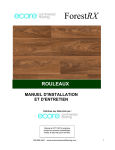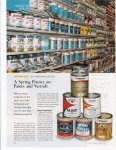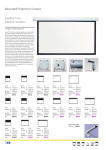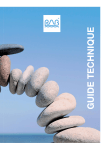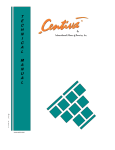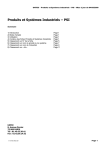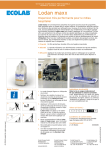Download Henkel SubFloor User's Manual
Transcript
Technical guide Technical guide 168 to 175 Laying procedures 171 Tiles 172 Sheet 173 Saga 174 Conductive, dissipative and antistatic floorcoverings 174 Conductive flooring with conductive adhesive and conductive primer 175 Laying procedure for residential sheet products 176 Cold and hot welding 177 Adhesives 178 to 181 Maintenance PREPARING THE SUBFLOOR The flooring contractor has responsibility for laying the floorcovering only when he is satisfied that the subfloor is in a suitable condition to receive the flooring. Local regulations regarding subfloors and the installation of floorcoverings must be complied with. GENERAL INFORMATION (NEW SUBFLOORS OR RENOVATION) The subfloor must be absolutely hard, level, dry, smooth and structurally sound. The subfloor must be free of cracks and other irregularities and must not be contaminated with paint, plaster, oil, grease or any other substance which could affect adhesion. Cracks must be filled with an appropriate material. 168 169 Technical guide The following information provides you with basic installation procedures. For technical products or more detailed instructions please refer to our technical guide. Technical guide Technical guide Laying procedure for tiles Hardness Use cement based products for subfloor preparation. They must be neither crumbly nor flaky. Flatness Unpack the tiles 24 hours before laying and make sure they are stacked horizontally. Minimum ambiant temperature must be 15 °C. Maximum deflexion, for a 2 m ruler 7 mm, for a 0.20 m ruler 2 mm. Surface state: fine and regular. Dryness Moisture content in subfloors should be measured using appropriate devices and should be in accordance with relevant standards in each country. The relative humidity must not be higher than 75 % R.H. Adapt the drying time according to how cold or damp the conditions are. Smoothness 1. Trace a line perpendicular to the main entrance. Trace a perpendicular line to this axis ensuring equal cuts for tiles on both sides. A smoothing compound must be applied to the entire surface according to the standards mentioned above. Smoothing compounds are not designed to overcome levelling deficiencies. The smoothing compound must be allowed to dry in accordance with manufacturer's instructions. Rub down using a carborundum stone in order to obtain a perfectly smooth surface. Sweep or vacuum up any dust. Spread the adhesive. Expansion joints or movement joints Floorcovering should be laid up to the joint and the joint should be covered with an appropriate plastic or metal sliding joint cover. 2. Apply adhesive to a few square metres of subfloor in one quarter. Insufficient open time of the adhesive will cause bubbles. If open time is too long the adhesive transfer will be poor. Subfloors direct to ground A damp-proof membrane must be laid under the concrete to act as a waterproof barrier against underlying hydrostatic pressure and moisture. Underfloor heating The subfloor must be allowed to dry in accordance with local standards. The heating system should have been switched on at least 4 weeks before laying the floorcovering, then switched off 24 hours before any subfloor preparation, and remains switched off during installation of the floorcovering. The heating should then be switched on 48 hours after installation of the flooring and the temperature progressively increased to normal working temperatures over 5-7 days. Glueline temperature < 28 °C (contact technical department for further information.) 3. Press each tile into position ensuring joints are butted tight. Beware installation directions according to pattern. Old carpeting Remove, clean the subfloor and apply a smoothing compound. 4. Smooth down manually then roll with a 50 kg flooring roller. Wooden floorboards Check the condition of the floorboards, secure any loose boards. Any knotholes to be filled as necessary. Cover with hardboard, chipboard or plywood, minimum thickness 8 mm. These sheets should be nailed or stapled every 10-15 cms. Check that the floorboards are dry and ventilated on the underside. All non ventilated woodenfloors must be removed. Ceramic tiles Any loose tiles must be stuck down and any traces of paint, plaster, grease, etc, must be removed. The cleaned tiles must be primed with an appropriate primer prior to applying a smoothing compound fully in accordance with manufacturers instructions. Leave to dry then rub down to a smooth finish. Sweep thoroughly. Apply the adhesive in accordance with manufacturers instructions. 5. If necessary heat weld seams 24 hours after installation. Do not traffic the floorcovering for 48 hours after installation. Old vinyl flooring 170 171 Technical guide Technical guide Old vinyl, linoleum and rubber floorcoverings should always be removed and the subfloor be examined and prepared as necessary before installing new floorcoverings. Technical guide Technical guide Sheet laying procedure Laying procedure for Saga Overall adhesion with tackifier emulsion adhesive The sheets must be unrolled and left in the room to be covered, with the adhesive, for at least 24 hours prior to laying. Minimum temperature must be 15 °C. 1. Lay first length along guide line, ensuring sheets are laid lengthways in the same direction as the light falls. Beware installation directions according to pattern. 2. Fold back sheets half way. A gripping primer compatible with the tackifier emulsion adhesive and the subfloor must be applied before gluing. 1 - Positioning of the floor covering The tiles should be removed from their box at least 24 hours before laying and placed in the room in which they are to be used 2 - Tackifier emulsion adhesive The tackifier emulsion is applied in a single coat: • using a finely notched trowel, quantity 100 to 150 g/m2, type A1, • using a foam roller, quantity 100 to 150 g/m2. 3 - Laying of tiles. Alignment. A - When laying the tiles, the following points must be respected: • use whole tiles or large cut tiles (more than 50% of the original tile size), in heavy traffic zones (door thresholds, corners in corridors, waiting areas), • align a row of tiles along the main access paths, • align one of the start lines with the longest wall-to-wall direction in the room. B - Alignment. Trace a guide line along which the tiles are to be laid (see fig 1). 4 - Preparation of subfloor and laying of tiles. 3. Use a finely serrated trowel to apply the single stick acrylic emulsion adhesive. The adhesive manufacturer's instructions must be followed. Insufficient open time of the adhesive will cause bubbles. If the open time is too long the adhesive transfer will be poor. 4. Smooth down manually then roll with a 50 kg flooring roller. Beware installation directions according to the pattern. • • • • Spread the tackifier emulsion adhesive over half the room. Lay the first row of tiles along the axis perpendicular to the door. Block this row in place using the wall as a support (see fig 2). Lay the following rows of tiles and block them against the first row. 5 - Smoothing. This operation must be carried out in two stages . • Smooth down manually. • Roll with a 50 kg flooring roller over the entire surface. Positioning of furniture. When positioning furniture, pay attention not to drag heavy objects over the floorcovering 1 1 2 2 1 Tracing the guide lines: • axis perpendicular to main entrance, • the perpendicularity of this axis is balanced by the tile cuts. 2 • Starting in the middle of the room, lay the tiles of the middle row. Block this row in place using the wall perpendicular to this row as a support. • Lay the following rows of tiles and block them against the first row. 5. If necessary groove and heat weld the joints after 24 hours after installation. Do not traffic the floorcovering for 48 hours after installation. 172 173 Technical guide Technical guide Other cases: Reverse lay the following products: Nera Contract, Taralay Comfort. Please note the reverse lay symbols on the packaging. Most sheet products are laid by overlapping the edges and cutting through. Tarasafe Standard, Tarasafe Iona, Tarasafe Comfort, Tarasafe Plus, Tarasafe Ultra, Tarasafe Style, Tarasafe Super however should be laid with a 1 mm gap to allow for the grooving machine. Grooving should be done manually. Technical guide Laying procedure Technical guide Laying procedure For conductive, dissipative and antistatic floorcoverings For residential sheet products Antistatic products Normal laying using high performance acrylic adhesive which has low water content. The flooring has antistatic properties of its own. These properties do not depend on the laying method used. Copper strips are not necessary. Dissipative products and conductive products There are two laying systems: • with conductive adhesive and conductive primer, • on a copper strip grid with a high-performance acrylic adhesive which has low water content. Copper strips: code 0584 Width: 1 cm Average length: 250 lm Thickness: 6/100 mm Weight: about 3.6 kg LAYING PROCEDURE FOR CONDUCTIVE FLOORING WITH CONDUCTIVE ADHESIVE AND CONDUCTIVE PRIMER LAYING PROCEDURE FOR RESIDENTIAL SHEET PRODUCTS The sheets must be unrolled and left in the room to be covered, with the adhesive, for at least 24 hours prior to laying. Minimum ambiant temperature must be 15 °C. 1. Apply a conductive primer. The coverage should be 100-150 g/m2. Leave to dry for at least 12 hours. Check that the subfloor on which you intend to lay the floorcovering is smooth, free from grit, grease and wood treatments. Most of these floorcoverings should not be laid over damp areas although Texline and Griptex have higher tolerances for damp. Please refer to the Technical Department for further advice. The floorcovering should be placed in the room where it is due to be laid for at least 2 hours prior to laying. The temperature should no less that 18oC. 2.1 Sheets Lay first length along guide line, ensuring sheets are laid lengthways in the same direction as the light falls. If you plan to lay two or more widths please ensure sufficient material is purchased to allow for pattern match. 2.2 Tiles Trace a line perpendicular to the main entrance. Most installations can be safely loose laid whilst ensuring that exposed edges that may be kicked up (such as doors and joints) are securely adhered to the floor using an 8 to 10cm width application of Gerflor E120 adhesive. Joints should be treated with Gerflor Cold Weld Liquid SG916 to ensure a strong bond. We recommend threshold strip to be fitted to doorways. Trace a perpendicular line to this axis ensuring equal cuts for tiles on both sides. 3. Use 2 lm of copper strips for every 30 m2 for earthing. Connect the copper strip to the earth (1 earth for every 30 m2). For rooms over 30 m2, lay copper strips at the periphery of the room and on the diagonal. Sheet lengths should be reversed laid. For permanent installations or where heavy domestic furniture such as washing machines are likely to be moved around, the floor covering can be fully adhered to the subfloor. 5.1 Lay the sheets. 5.2 Lay the tiles. 6. Smooth down manually then roll with a 50 kg flooring roller. 7. Groove and heat weld the joints 24 hours after installation (compulsory). Dried adhesive on surface of flooring may be removed with alcohol or turpantin. Do not traffic the floorcovering for 48 hours after installation. 174 175 Technical guide Technical guide 4. Adhering with acrylic single stick conductive adhesive (type Cégé 100 Conductrice - Akzo-Nobel) and a sharp-serrated notche, or similar approved adhesive. The coverage should be approximately 200-300 g/m2. In order to achieve a regular and appropriate coverage change the spatula regularly. Carefully follow the manufacturer's instructions when applying primer and adhesive. Ensure that the supplier can provide a 10 year guarantee for the conductibility of the adhesive. Technical guide Cold welding Cold welding with SG 916 or TARAJOINT is necessary to create a continuous hygienic surface. If this treatment can withstand traction of 8 daN/cm, the P3 requirement has been met. 1. Overlap the edges by 3 or 4 cm and cut through both thicknesses with a stanley knife using a ruler as a guide-line. It is beneficial to place a flat straight edge beneath the joint to be cut. This will avoid damaging the subfloor and ensure a tight butt joint is achieved. Butt the sheet edges together to form a compression joint. Technical guide Adhesives PRINCIPLES FOR SUCCESSFUL ADHESION Instructions for use are given by the adhesive manufacturer. These are given for normal hygrometric conditions and subfloor porosity. They may need to be modified according to on-site conditions. MAIN TYPES OF ADHESIVE 2. Cover the joint with paper adhesive tape. 3. Cut through the tape into joint. 4. Fit the necessary nozzle onto the bottle, depth welding: nozzle with guide, surface welding: feed nozzle. Insert nozzle into joint and squeeze bottle until there is an excess of liquid on the surface of the tape. Wait for 60 seconds. 5. Remove adhesive tape. Water-based or emulsion : suitable for most types of flooring. Their bonding capability is determined according to their rate of evaporation. They are normally applied with a finely notched trowel or roller. Contact adhesive : These are resins in solution and flammable. They are usually double stick and applied using a stiff brush or trowel. Polyurethane contact adhesive is recommended for difficult areas eg. Skirting pannels to PVC Two part adhesives. This type of adhesive (epoxy + polyurethane) is used for flooring subjected to heavy traffic, dampness or exposure to the elements. Single application. RECOMMENDED ADHESIVES PER PRODUCT TYPE For more information please contact our technical department. Hot welding Allow 24 hours after laying. Welding can then be done either manually or mechanically using a welding machine and weld rod. 1. Grooving can be done manually or mechanically using an electric grooving machine. • Foam backed vinyl: only groove through the depth of the wearlayer. • Homogeneous material: the depth of the groove should be equal to the total thickness of the material minus 0.3 mm. Tarasafe, Tarasafe Comfort, Tarasafe Ultra, Tarasafe Style, Tarasafe Super : it is recommended to butt joint leaving a 1 mm gap. 2. Mechanical or manual welding. 176 177 Technical guide Technical guide 3. Trimming the joint: • first trim using a crescent bladed knife with a cable slide, • when the joint has fully cooled, trim for a second time with a crescent bladed knife to ensure that the weld rod is flush with the floorcovering. For E3 classification it is compulsory to install set-in coved skirting with a welded joint. Maintenance Gerflor floorings, in common with all heavy duty floorings, require correct and regular maintenance. Whatever the manufacturing finish, satisfactory results can only be obtained by following certain basic maintenance rules. Rubber leaves indelible stains on vinyl floorings : ■ do not use mats with rubber backing ■ replace tubular furniture feet with those made of PVC or polyamide (do not use rubber furniture feet and wheels) Never use solvent-based wax, seals, polishes or varnish, particularly those containing acetone and other PVC solvents. Place a barrier mat (which does not have a rubber backing) in doorways and entrances. Delay maintenance until 72 hours installation for rolls and an entire week after installation for tiles. Six types of maintenance are recommended according to the floorcovering installed : Technical guide • Very low maintenance = floorings with PROTECSOL® treatment • Very low maintenance for high quality homogeneous flooring PUR PROTECT® 178 • Low maintenance = floorings with polyurethane (PUR) treatment • Normal maintenance for homogeneous floorings PU treated. • Normal maintenance = non treated floorings • Specific maintenance = antistatic and conductive floorings VERY LOW MAINTENANCE PRODUCTS With PROTECSOL® treatment: Taralay Impression, Brazilia, Forum, Jamaïca, Metallica, Saga. With SPARCLEAN® treatment: Tarasafe Style, Ultra. With PUR protect treatment: Mipolam Elegance 290, Mipolam Esprit 500. It is not necessary to seal the floor during its lifetime, the maintenance cost will be greatly reduced during the life of the floor. INITIAL CLEANING Remove loose debris after the installation of floor. Wash floor with a low speed cleaning machine (150200 rpm) fitted with a red pad. Use neutral detergent. Ensure that all detergent residues are rinsed and removed from the floor. PROTECTION This step also know as "metallisation", "self-shine", or "polishing", is not necessary. DAILY MAINTENANCE Remove dirt with a damp mop and neutral detergent. Dry sweeping is also possible. Mechanical maintenance provides better aesthetic results. PERIODIC MAINTENANCE Clean with a high speed (450 rpm) machine fitted with a red pad or nylon brush or scrubbing machine + neutral detergent. LOW MAINTENANCE PRODUCTS With PUR treatment: Nera Contract, Mipolam Activa 250, Mipolam Troplan 100, Classic Imperial, Ambiance, GTI, GTI AS Decor, Attraction™, Creation*, Artline*. * Except Slate and Peeble PUR treatment is a protective polyurethane surface treatment applied to the product during the manufacturing process. Results : it is not necessary to seal the floor after installation. Protection is required when aesthetic and hygienic proper ties are judged unappropriate by maintenance staff. In the meantime, maintenance costs are reduced. INITIAL CLEANING Remove loose debris after the installation of the floor. Wash floor with a low speed cleaning machine (150-200 rpm) fitted with a red pad. Use neutral detergent. Ensure that all detergent residues are rinsed and removed from the floor. PROTECTION This step also know as "Metallisation", "selfshine", or "polishing" is only necessary when aesthetic and hygienic properties are judged unappropriate by maintenance staff. DAILY MAINTENANCE Remove dirt with a damp mop and neutral detergent or floor maintainer. Dry sweeping is also possible. PERIODIC MAINTENANCE Clean with a high speed (450 rpm) machine fitted with a red pad, or nylon brush, or a scrubbing machine + neutral detergent, or floor maintainer. NORMAL MAINTENANCE PRODUCTS With PU factory seal : Univers Non treated floorings: Architecton, Tarasafe ranges. INITIAL CLEANING Remove loose debris after the installation of floor. Wash and clean off with a machine fitted with blue or green pad + stripping agent at 150200 rpm. The brown pad is suitable for removal of heavy dirt and/or grease. Ensure that all detergent residues are rinsed and removed from the floor. PROTECTION This step is also know as “metallisation”, “self-shine”, or “polishing”. It is usual to apply 3 coats of polish to new floors, as this will impair the slip resistance, allowing one coat to dry before applying the next coat. Do not go through this treatment with the following products: Tarasafe, Tarasafe Iona, Tarasafe Comfort,Tarasafe Ultra, Tarasafe Style, Tarasafe Super, to keep their slip resistance properties. DAILY MAINTENANCE Remove dirt with a damp mop and neutral detergent or disinfectant. Dry sweeping may be sufficient. PERIODIC MAINTENANCE Clean with a high speed (450 rpm) machine fitted with a blue or red pad using a spray detergent or floor maintainer. For Tarasafe ranges, clean with a machine fitted with a blue or green pad (450 rpm) or a scrubbing machine + neutral detergent. Every year protection should be removed and reapplied. 179 Technical guide Maintenance FLOORS WITH PROTECSOL® : NEVER POLYMER EMULSION OR DISPERSION Technical guide 180 181 Technical guide AZ 70 SUPER CLEANER DYNATECH ALKA SPAY CLEANER SPRAY EMULSION RENEWAL OF POLYMER EMULSION HOSPITAL POLYMER EMULSION POLYMER EMULSION POLYMER DISPERSION PRIMER STRIPPER (DRY) STRIPPER MOP WAX DYNATECH MULTISPRAY DYNATECH CLEAN FORCE SUPER CLEAN RESISTO DES TOP SPRAY UNDUR F GEMSTAR LASER LODAN STAR ISI STAR TUKLAR SUPER METALLIC DYNATECH PROTECTION DYNATECH FORCE OPTIMA DYNATECH TRIO DYNATECH FORCE PRESEAL XL SPIRIT SEALER NOVASEC BENDUROL FAST BENDUROL FORTE INDUR BRILLANT PLUS INDUR TOP HELOTISTAR DIESIN PLUS FJORD PLUS BENDUROL FAST NEOMAT RENOVANT NEOMAT A GLOSS EXPRESS BRIAL CALYPSO 8, rue Rouget de Lisle 92442-ISSY-LESMOULINEAUX T: +33 1 40 93 93 86 F: +33 1 40 93 93 97 www.henkel-ecolab.com DYNATECH PREBASE LONGLIFE CLEANER R QUICK STRIPPER DYNATECH SUPER STRIPP DYNATECH STRIPP DYNATECH SECCO TAWIP AR 80 B 250 SPRAY DETERGENT TAWIP C DYNATECH BACTISPRAY DYNATECH PHENIX CLEANING AGENT (HIGH TRAFFIC) APESIN AP3 DYNATECH DUO DYNATECH CLEAN BACTO QUICK STRIPPER FLA 710 S LINAX PLUS BLINK ECOLINE N° 7 DYNATECH CLEAN FORCE DYNATECH CLEAN FRESH DYNATECH STRIPP gamme Werner & Mertz gamme Colgate Palmolive DESINFECTANT DETERGENT CLEANING AGENT (REMOVING RUBBER MARKS) CLEANING OF POLYMER EMULSION PROTECTIVE LAYER BASIC LAYER STRIPPING Cigarette burns : For calendered products : rub gently with a very fine grade sandpaper, or fine wirewool. Apply a self-shine emulsion over the entire surface. ALKALINE CLEANING AGENT Heavy grease – Paint – Rubber scuffs – Hair colourings – Food fats – Ball point or felt-tip pens : Petrol. White Spirit. Scrub using an undiluted detergent, rinse thoroughly and remove all residues. DETERGENT CLEANING Sweep the floor thoroughly. Add a small amount of neutral liquid cleaner to warm water and clean floor thoroughly. After cleaning the floor must be rinsed with clean water to remove all traces of the cleaning agent. NB: Manufacturers' recommendations for dilution rates, usage and rinsing should be strictly adhered to. Rust : Use either proprietary antirust treatment or oxalic acid (rinse thoroughly). NATURAL CLEANING AGENT Caring for Gerflor cushioned vinyl It is important to clean the floor regularly to avoid any build up of dirt and grit that can damage the surface. TYPE OF PRODUCT: RESIDENTIAL FLOORING WASHING TYPE OF PROCESS: INITIAL CLEANING Remove loose debris after the installation of floor. Wash and clean off a machine fitted with blue pad + stripping agent (such as REMAT manufactured by WETROK) at 150-200 rpm. Ensure that all detergent residues are rinsed and removed from the floor. The green pad is suitable for removal of heavy dirt and/or grease. PROTECTION This step is also know as "metallisation", "self-shine", or "polishing". Do not protect the floors in surgery rooms : only apply one coat of MEPOL HMA manufactured by WETROK or equivalent complying with electrical properties. ADRESS: Parc des Barbanniers F-92230-GENNEVILLIERS T: +33 1 41 47 35 71 F: +33 1 41 47 35 95 www.wmprof.com PERIODIC MAINTENANCE Clean with a high speed (450 rpm) machine fitted with a red pad or nylon brush + neutral detergent. JONTEC RESTORE JONTEC ASSET JONTEC ETERNUM JONTEC RESITOL JONTEC ETERNUM JONTEC LUNA JONTEC TECHNIQUE JONTEC STRIPO JONTEC N° 1F JONTEC FUTUR JONTEC EXTRA JONTEC COMBINET JONTEC ASSET JONTEC TENSOL SPRINT DEGRAGERM SPRINT DS 5001 JD ATTACK PLUS JONTEC COMBINET JONTEC STRIDE JONTEC DEGRAISSANT JONTEC ASSET JONTEC 300 gamme Jontec 9, 11 av. du Val de Fontenay 94133-FONTENAY-sous-BOIS T: +33 1 45 14 76 76 F: +33 1 45 14 76 11 www.johnsondiversey.com TASKI P44 (<300t/mn) TASKI OMNISPRAY TASKI VISION MATT TASKI VISION STAR TASKI VISION MATT TASKI VISION SILK TASKI VISION STAR TASKI OMNISTRIP TASKI RADICAL TASKI TOP SHINE TASKI COMBIPLUS TASKI TENSIO TASKI COMBIBEST JD ATTACK PLUS TASKI FORCE TASKI R50 gamme Taski JOHNSON DIVERSEY Blood – Urine – Faeces : Use diluted bleach and thoroughly rinse with water to remove all residues. Vinegar – Tomato – Mustard : Add a few drops of ammonia to water, this may remove the stain. ECOLAB Static control floorings : Mipolam Robust EL7, Mipolam Technic EL5, Mipolam Forum EL5. STAIN REMOVAL TABLE W & M FRANCE PROFESSIONAL SAS DAILY MAINTENANCE Damp mop and neutral detergent and disinfectant to remove dirt. COMPANY: SPECIFIC MAINTENANCE PRODUCTS OTHER FLOORS TO PROTECT PROCUR diluted THERMOHOSPITAL THERMODUR COPEX POLY-EX LI-EX COPEX POLY-EX LI-EX ARISTON PROCUR diluted RAPID LI-EX COPEX DOPOMA INTENSO VERIPROP 1, rue de l’industrie-BP 54 F-67172 BRUMATH CEDEX T: +33 3 88 59 52 25 F: +33 3 88 59 52 20 [email protected] KIEHL FRANCE Maintenance Maintenance Technical guide Notes Due to printing limitations there may be variations between the colours of the actual flooring and illustrations shown in this catalogue. Samples are available upon request. 182








